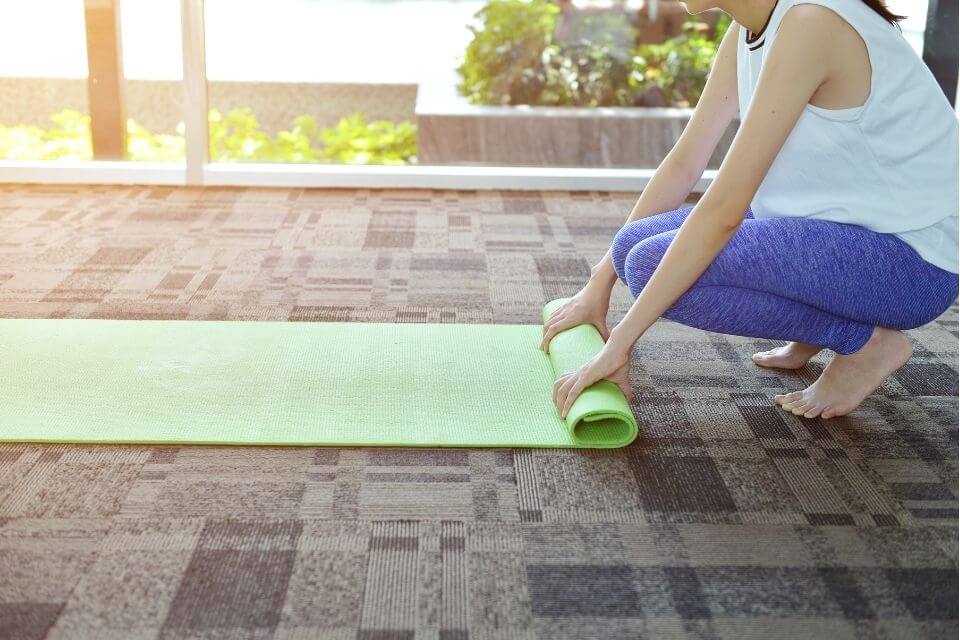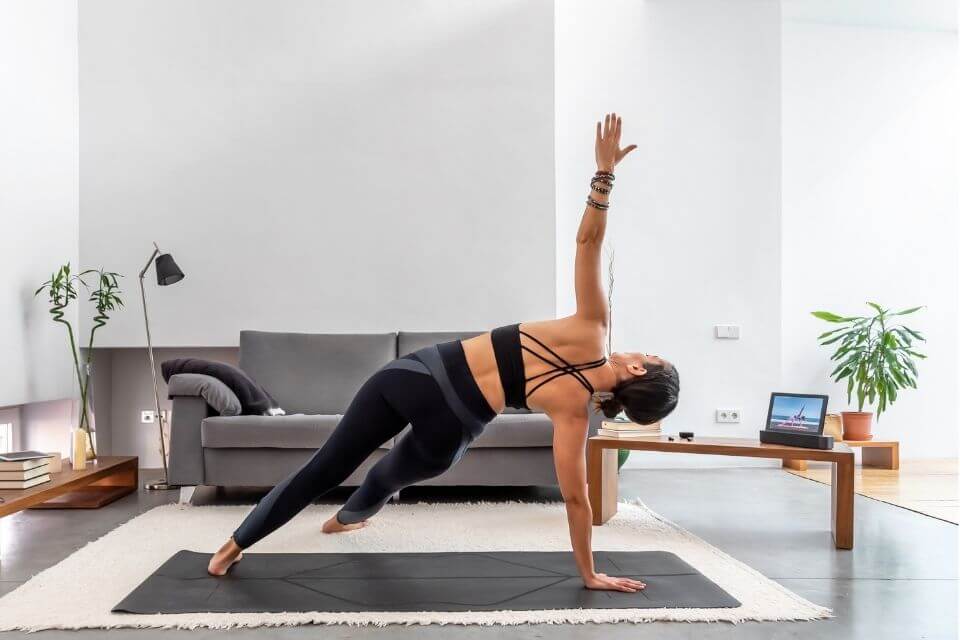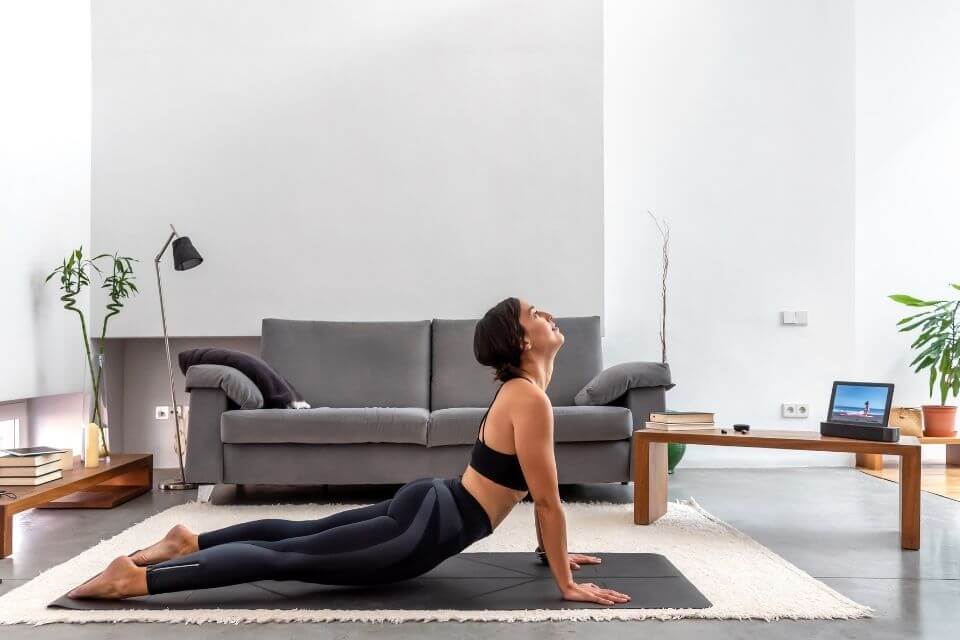In a world full of stress and chaos, it is not difficult to understand why many people enjoy peaceful meditation and relaxing exercises to unwind and recharge.
Yoga is an ancient discipline originating from India that has spread throughout the globe for decades. It is a holistic practice that promotes a healthy mind, body, and spirit, and more and more people are getting hooked.
If you are one of those people who want to practice yoga daily, but your busy schedule doesn’t permit you to, don’t fret. There is something you can do about it.
Many yogis have resorted to practicing the art of yoga in the comfort of their own homes. Aside from it being so much more affordable, it also allows you to perform your asanas (poses) whenever you want to. All you need are some yoga DVDs or online tutorials, a yoga mat, a small spot on the floor, and you are all set!
Need a new yoga mat or carpet for yoga? Check out our complete guide on the best yoga mats.

Best Yoga Mat For Carpet
When practicing yoga on a carpeted floor, picking the best yoga mat could be a little complicated. You cannot simply use your existing mat or buy whatever you find available in your local sporting goods store. No, you will need a special kind of yoga mat – one equipped with an underside that can grip well onto the carpet.
Getting this type of yoga mat is crucial in allowing you to move freely on a carpet without sacrificing your balance. While it is admittedly not the cheapest option, think of it as a good investment, especially if you take yoga seriously. You will thank yourself in the end if you do.
There are many carpet-appropriate yoga mats that you could choose from. It is just a matter of preference. Among the best yoga mat options in the market that expert practitioners recommend are the Manduka Prolite Yoga and Pilates Mat .
Now, say you have tried every yoga mat available and still cannot stand doing that downward-facing dog on the carpet. Is it time to call it quits and opt for a different activity instead? Do not give up just yet: you can still find that yoga bliss by purchasing a portable, flat, non-slip surface that will let you do yoga without your carpet getting in the way. An example of this product is called LifeBoard.
A less expensive alternative to LifeBoard is to create your surface – also known as a yoga platform. It might take a little bit of work, but it is a one-time effort that is worth trying, especially if you are on a budget.
It is pretty interesting to know that yoga mats were not invented until the 1960s. Long before yoga mats came about, ancient practitioners practiced yoga either on grass or on a rug made of animal skin. When yoga poses started becoming more challenging, there arose the need for better cushioning. People then began using cotton towels, which eventually evolved into rugs made of synthetic cloth.
In the 1960s, German yogi Angela Farmer tried using a piece of foam carpet underlay in her practice that the modern yoga mat was born. It then became every yoga practitioner’s best friend.
The importance of a mat to a yogi’s life cannot be stressed enough. Aside from protecting you from the cold and hard surface of the floor, it also helps you from slipping and sliding, putting your hands and/or feet firmly into place as you do your poses. Most importantly, your yoga mat is your space of solace: that solemn, peaceful spot where you can de-stress and energize your chakras.

Practicing Yoga on Carpet
When practicing yoga at home, the only small problem you might face is that your entire house might be carpeted. To those not familiar with yoga, this might seem like a non-issue, but it does pose some challenges.
To some, doing yoga on the carpet only takes a few weeks of getting used to and then becomes a non-issue. However, most yogis recommend against it. For one, doing yoga poses against a carpeted floor might give your body friction burns or scratches caused by sliding your body against the carpet. If you don’t want to suffer from unnecessary abrasions on your road to fitness, you might want to consider other options.
Hygiene is another concern people have against doing yoga on the carpet. Think about it, carpets are prone to dirt and dust accumulation and can be such a hassle to clean. Imagine yourself lying on your back or belly, exposing your body to a most likely filthy surface, for an hour or two a day. Now that doesn’t seem clean. And it’s not like you can get your carpet professionally cleaned every other day. Not only is it expensive, but it is extremely impractical as well.
For the sake of argument, though, let’s say you are fine practicing yoga on the carpet, and you decide you want to keep doing it despite the above challenges. You might not find any issues initially, but you run the risk of completely ruining a perfectly good carpet in the long run. If you use the same spot repeatedly, that portion of your carpet will fade over time.
Considering that carpets are generally expensive, using them as a yoga mat may not be worth it.

Find Your Peace
Deciding whether or not to practice yoga on the carpet, with or without a mat, is your call. Try and see if it works. If it doesn’t, then you have the freedom to try out other options. After all, the ultimate goal of yoga is moksha or liberation, so you are free to do whatever helps you find inner peace.
What yoga mat material is best for carpeted floors?
Most people think of yoga as a gentle, calming exercise. But some forms of yoga can be quite rigorous, and if you’re doing them on a hard surface like concrete or wood, you could end up with bruises or worse. A better option is to use yoga flooring over carpet. Yoga flooring is designed to cushion your body and provide a bit of grip so you don’t slip around.
The best yoga mat material for carpets is made from rubber, which is soft and durable. Rubber mats are also easy to clean and maintain. Some yoga practices in Scandinavia use cotton futon mats. However, they tend to be expensive. If you want a cheaper option, consider using foam mats instead. Foam mats are inexpensive, but they may leave marks on the floor.
In conclusion, practicing yoga on a carpeted floor is a great way to avoid slipping and sliding. Not only will you be able to maintain your balance, but you will also protect your mat from dirt and dust. If you don’t have a yoga mat, don’t worry! You can still practice yoga on your carpet without any issues. Just be sure to use a towel or blanket for extra cushioning.
